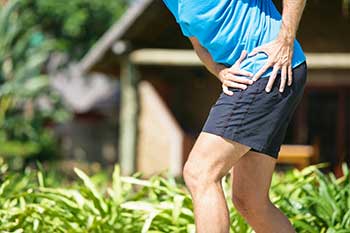Over the past 30 years of his practice, Dr. Bomberg has been at the forefront of modern orthopaedic hip care. His continuing education and training have led to several firsts for his practice. Dr. Bomberg was the first in the valley to perform arthroscopic hip surgery for the relief of femoroacetabular impingement (FAI). FAI is an all too common affliction of the hip where the head has a bump that produces damage or a very prominent lip of the cup is present that pinches on the head. Commonly both conditions are present. In the past, only an open surgery with dislocation of the hip could relieve the condition. Now, arthroscopic removal of the extra bone on the front of the cup and/or removal of the femoral head bump can be performed as an outpatient arthroscopic procedure. Repair of labral cartilage damage completes the surgery. This surgery is often a hip sparring maneuver to prevent the formation of arthritis.
The use of the arthroscope revolutionized the surgical approach to the knee in the seventies (knee arthroscopy). The most common use of the arthroscope is to remove torn meniscus. The arthroscope can be used to remove damaged cartilage, loose bodies, plical shelfs, and other knee problems. Isolated cartilage loss can be addressed with microfracture surgery(PDF) in appropriate candidates. A good discussion of the various approaches to isolated knee cartilage loss is Articular Cartilage Restoration. Another common use of the arthroscope is for ACL anterior cruciate ligament reconstruction.
Arthroscopic knee surgery is performed as outpatient surgery. After you check into the hospital the day surgery personnel will take you back to the day surgery unit where you prepare for surgery. The nursing staff asks lots of questions and examines you in preparation for surgery. The anesthesiologist will visit and discuss your needs for the surgery. If a larger surgery such as tibial tubercleplasty, patellar stabilization with MPFL reconstruction, or ACL reconstruction is planned they will often offer a nerve block for your postoperative comfort. This will be done in the day surgery unit or back in the operating room. They will then discuss the anesthetic for the surgery, the usual choices being a spinal block or general anesthesia. They will discuss the pros and cons of each approach and any special recommendations for you. After surgery, you will be taken to the recovery room for early recovery and then on to the day surgery unit until you are ready to go home. Dr. Bomberg will discuss your surgical findings with you and a significant other after surgery. An information sheet (available on the website for most procedures) will be provided and specific directions given. Prescriptions, physical therapy orders, pictures of your arthroscopic surgery, ice and possibly knee braces will be provided. Usually, instructions on suggested dates for follow-up are given and you will need to call the office to confirm a time. In general, we will recheck the knee between 5-10 days post-op.
After the arthroscope revolutionized the surgical approach to the knee in the seventies it completely changed the surgical options for the shoulder. Shoulder arthroscopy allows for intervention in most of the common shoulder surgeries. With an arthroscopic procedure, we can remove damaged cartilage, loose bodies, bone spurs, repair biceps tendon tears, rotator cuff tears and stabilize the shoulder ligaments. In the past, the only way to repair a torn rotator cuff tendon was with open surgery, but now these tears are best dealt with by arthroscopic surgery (rotator cuff tears). When the shoulder is painful and has shoulder impingement, tendinitis, and bursitis, the arthroscope allows us to treat these conditions with a manageable procedure allowing for rapid recovery and return to work and sports (Shoulder impingement). Unstable shoulders that dislocate can be repaired with the use of the arthroscope (A patient’s experience with chronic unstable shoulder).



